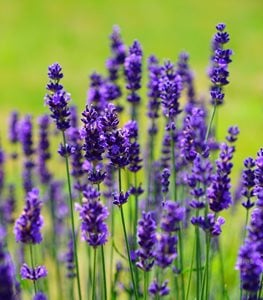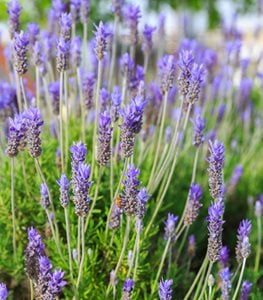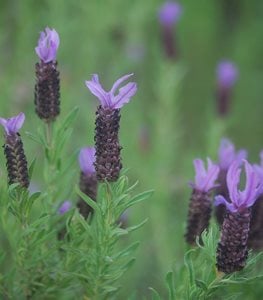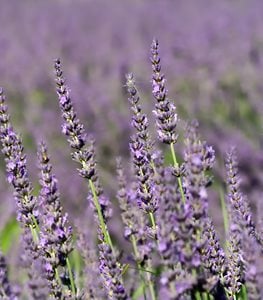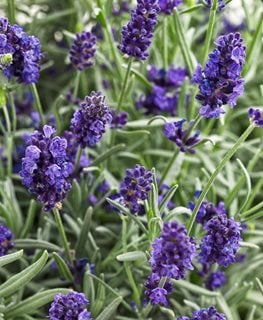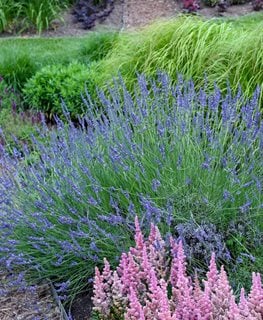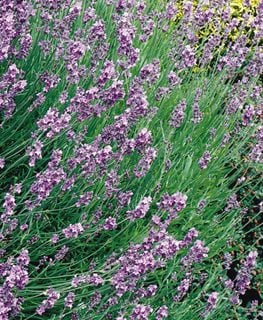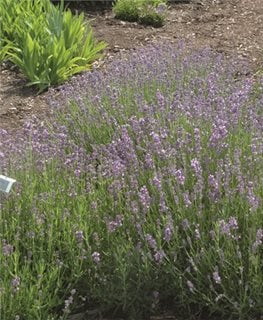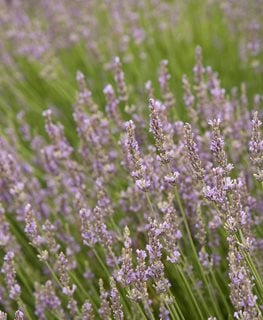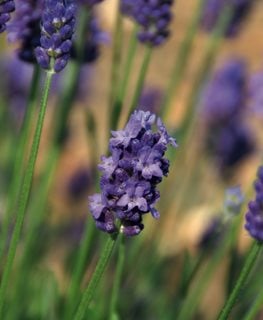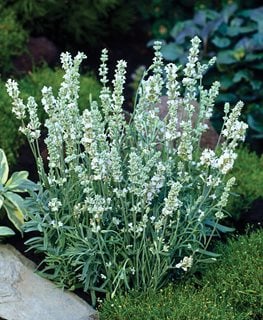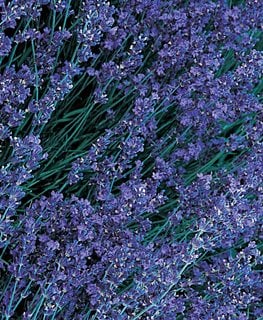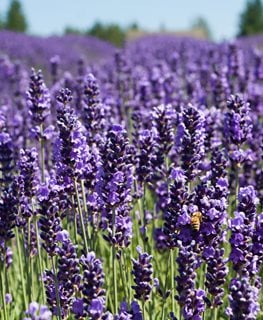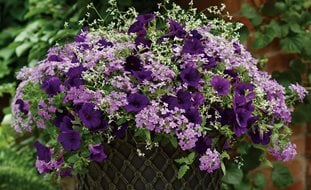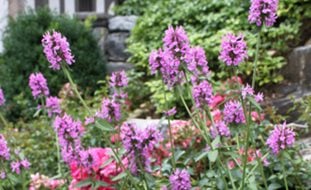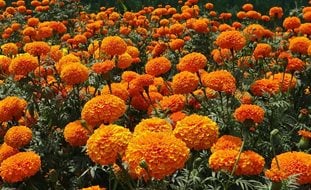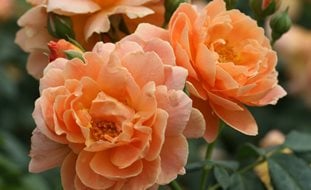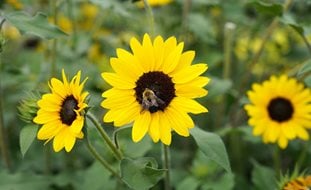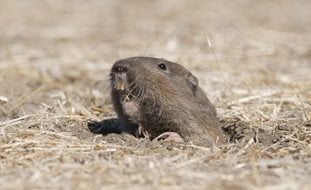Lavender Plants: Essential Growing Guide, Types, and Care
Learn about the different types of lavender, and get tips for growing and planting this fragrant, easy-care plant.Lavender makes a stunning addition to borders and perennial gardens, providing sweeping drifts of color from early summer into fall. With its silvery-green foliage, upright flower spikes, and compact shrub-like form, lavender is ideal for creating informal hedges. You can also harvest it for fragrant floral arrangements, sachets, and potpourri, as well as many medicinal and culinary uses.
Although all lavender (Lavandula) is native to the Mediterranean, there are many different varieties offering a vast selection of bloom times, flower forms, and sizes. And, contrary to the name, not all lavenders are purple. Some hybrids come in other lovely pastel hues such as violet blue, rose, pale pink, white, and even yellow. The leaves can also vary in shape and color. To extend the bloom season, as well as the color palette, consider planting several varieties.
COMMON TYPES OF LAVENDER
There are four main types of lavender commonly grown in home gardens—each with unique characteristics in bloom time, fragrance, and climate tolerance. Here’s how they compare.
ENGLISH LAVENDER
Botanical name: Lavandula angustifolia
Zones: 5-8
Bloom time: June to August
Height: 2 to 3 feet
Flower colors: Lavender, deep blue-purple, light pink, white
Despite its Mediterranean origin, English lavender was so named because it grows well in that country's cooler climate and has long been a staple in English herb gardens. The gray-green foliage and whorls of tiny flowers make this one of the most attractive lavenders in the garden. It’s one of the most cold-hardy varieties and the best for culinary use because of its low camphor content. Learn more about growing and harvesting English lavender.
FRENCH LAVENDER
Botanical name: Lavandula dentata
Zones: 8-11
Bloom time: Early summer to fall
Height: 36 inches and larger
Flower colors: Light purple
Also called fringed lavender, this showy variety is distinguished by narrow, finely-toothed leaves and compact flower heads topped by purple bracts. While the flowers have less aroma than English lavender, the fleshly leaves are more fragrant, with an intoxicating rosemary-like scent. Learn more about growing French lavender.
SPANISH LAVENDER
Botanical name: Lavandula stoechas
Zones: 8-11
Bloom time: Mid to late summer
Height: 18 to 24 inches
Flower colors: Deep purple
This variety is prized for its unusual pineapple-shaped blooms with colorful bracts, or “bunny ears,” that emerge from each flower spike. Although the flowers are not especially fragrant, the light-green leaves are very aromatic. Learn more about growing Spanish lavender.
LAVANDIN
Botanical name: Lavandula ×intermedia
Zones: 5-11
Bloom time: Mid to late summer
Height: 24 to 30 inches
Flower colors: Dark violet, white
This popular hybrid combines the cold hardiness of English lavender with the heat tolerance of Portuguese lavender (L. latifolia). It typically starts blooming a few weeks later than most English lavenders and features long spikes of highly fragrant flowers. Although not considered edible (due to high camphor content), the flowers and foliage are often added to sachets and potpourris.
HOW TO PLANT LAVENDER
"It's a good choice to put right next to a vegetable garden because it attracts pollinators like crazy—honey bees and butterflies—and the more pollinators we can get over to our vegetables the better harvest we'll have." —Laura Leboutillier, Garden Answer
When to plant:
In the spring after the soil has warmed up and the threat of frost has passed. May also be planted in the fall if you give plants enough time for their roots to establish before winter.
Where to plant:
Place these sun lovers in a site that receives ample sunlight (at least 6 hours daily). In shadier locations, plants will bloom poorly, lack vigor, and be less fragrant. An area that receives good air circulation is also important, especially if growing plants in a humid climate.
How to plant:
It is generally easier to grow lavender from nursery starts, since the seeds are small and tend to have a slow and erratic germination rate. To ensure good air circulation, space plants 2 to 3 feet apart, depending on their width at maturity. Water right after planting and continue to water every few days until plants become established.
Soil requirements:
Grows best in sandy, nutrient-poor, alkaline soil that provides excellent drainage. Avoid planting in heavy clay or in low spots prone to standing water. Because good drainage is essential, consider growing your plants in mounds, raised beds, or on slopes.
Growing from seed:
If want to try your hand at growing lavender from seed, start the seeds indoors in early spring, covering them very lightly with a sterile seed starting mix and keeping them moist but not soggy until the seedlings emerge. When kept at a temperature of about 65° F, the seeds will germinate in 2 to 3 weeks.
Growing in containers:
Compact varieties of lavender are perfect for growing in containers, which is a good option in areas where the plant isn’t hardy because you can move the pots indoors over winter. Be sure to plant in a high-quality, fast-draining potting mix in a container with multiple drainage holes, so your lavender won’t be sitting in standing water. Learn more about how to grow lavender in pots.
LAVENDER PLANT CARE
Watering: Established lavender plants are extremely drought tolerant and only need to be watered during prolonged dry spells. To prevent root rot and fungal diseases, avoid overwatering and keep the leaves dry by watering at ground level or using drip irrigation. During the winter, when plants are dormant, no supplemental watering is needed.
Amendments and fertilizer: Because lavender is native to regions having sandy or rocky soils with low fertility, avoid using amendments that enrich the soil, such as compost or other organic matter. If you have dense clay soil, amend it with inert rice hulls to improve drainage.
Fertilizing lavender is rarely necessary and may cause a surge in foliage growth at the expense of flower production. Plants will generally be more robust when grown in poor soil that is low in nutrients.
Overwintering: In climates where temperatures dip below zero degrees Fahrenheit, insulate your plants with a winter mulch of evergreen boughs, shredded leaves, or straw, especially if there’s a lack of snow cover. Proper soil drainage is also essential to plant survival in areas with cold, damp winters.
Propagation: From seed or by stem cuttings taken from new growth in spring, before flower buds form. *See note below on propagating or dividing patented plants (check your plant tags for the ® or ™ symbol by the plant name).
Pests and diseases: Lavender has few pest or disease problems, but can be susceptible to root rot and powdery mildew
HOW TO PRUNE LAVENDER
Pruning lavender is essential for maintaining its health and beauty. Regular pruning helps stimulate new growth, maintain the plant’s shape, and promote abundant blooming. Key pruning times include:
- Early spring to refine shape
- Late spring after the first bloom flush
- Mid-to-late summer after flowers fade.
- Light fall pruning can also be beneficial but should be done cautiously to avoid winter damage.
Proper techniques involve cutting back by one-third, shaping the plant into a dome, avoiding cutting into old wood, and always using sanitized tools. For more details, see A Beginner's Guide to Pruning Lavender.
Deadheading Lavender:
In addition to seasonal pruning, regular deadheading is another important technique to keep your lavender looking its best and encourage continuous blooming. Here are a few tips from Sean & Allison of Spoken Garden's video, How to Deadhead Lavender
- "When deadheading lavender, go down to the first set of leaves — often there’s a new flower bud just below the spent bloom. Cutting too far can remove this new growth."
- "The purpose of deadheading is to direct the plant’s energy to new blooms, not old ones — so removing just the faded flowers while preserving new growth is key."
- “Using hedge shears may be faster, but you risk cutting off all the new flower buds forming just beneath the old blooms. Hand pruners let you keep that fresh growth intact.”
POPULAR LAVENDER VARIETIES
FREQUENTLY ASKED QUESTIONS
Is lavender a perennial?
While lavender is often sold as a perennial, it’s actually an evergreen semi-woody shrub that will return year after year if grown in the appropriate climate. However, some types of lavender won’t survive winter when exposed to excessively cold temperatures. French and Spanish lavenders are particularly susceptible to frost damage and should be grown as annuals north of zone 7 or in containers that you can bring indoors during the winter months.
What is the best lavender for cold climates?
English lavenders and their hybrids are the best varieties for colder climates since they are hardy to zone 5, where winter temperatures can drop as low as -10° F to -20° F. Some of the hybrid lavandins (L. x intermedia) can also tolerate cold conditions. If your winters are particularly harsh, it’s best to grow plants in a protected location to prevent damage.
What is the best lavender for hot and humid climates?
Both Spanish lavender and French lavender are excellent performers in southern gardens with extremely hot, humid climates. However, be sure to grow plants in well-draining soil and space them far enough apart to permit good air circulation. Although English lavender will endure summer heat, it grows poorly in climates that have extremely hot, humid summers, preferring more temperate conditions.
How do I fix leggy or woody lavender plants?
Leggy lavender plants, with long woody stems and sparse growth, are often the result of improper pruning (see “How to Prune Lavender”). However, plants can also get leggy if they receive insufficient sunlight or are planted in overly fertile soil. To restore their bushy appearance, start by pruning your plants in the spring, cutting back to the lowest emerging bud. In midsummer, prune again to shape your plants into nice, symmetrical mounds, which will help keep them tidy and reduce straggly growth. Be aware that rejuvenating woody lavender can take time, so have patience and give your plants several months to recover between prunings.
How do I harvest and preserve lavender flowers?
Cut the flowers when the buds are just beginning to show color, but before they fully open. If you harvest the blooms when they are in early bud, they should last at least two weeks in a vase. This is also when the essential oils are at their peak.
If harvesting for dried flowers, tie the cut flower stalks into bunches and hang them upside down in a dry, well-ventilated space out of direct sunlight. Once dry, you can strip off the flowers to use for sachets and potpourri or create a dried bouquet by leaving the flowers on the stems and arranging them upright in a vase.
DESIGN IDEAS FOR LAVENDER
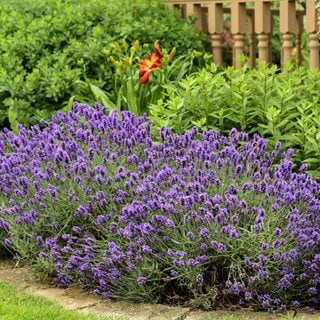
Sweet Romance® Lavender. Photo by: Proven Winners.
- Use along walkways and garden paths where you can enjoy their scent and where they can benefit from the heat reflected off the pavement.
- Plant in formal or informal herb gardens, where the cool, gray-green foliage sets off other green herbs and plants.
- Create aromatic hedges or borders along fences and garden walls as shown in this video for Sweet Romance® lavender.
- Use as a natural pest repellent near patios and porches. The scent deters mosquitoes, flies, fleas, and other problem insects while attracting butterflies and bees.
- Plant with drought-tolerant companions such as coneflower, sedum, black-eyed Susan, roses, and shasta daisies. See more lavender companion plants.
IDEAS FOR USING LAVENDER IN THE KITCHEN
A member of the mint family, lavender has been used for centuries as a versatile, unexpected flavoring in both sweet and savory foods. English lavenders are the best varieties for culinary purposes, and both the buds and leaves can be used fresh or dried. Because the flavor is strong, use it sparingly so it won’t overpower your dishes. The buds are best harvested right before they fully open, when the essential oils are most potent.
- Immerse a few dried lavender buds in a jar of sugar to give it a sweet aroma. Use the sugar for baking and in desserts.
- Chop the fresh buds and add to a cake batter or sweet pastry dough before baking.
- Add flower buds to preserves or fruit compotes to give them subtle spicy notes.
- Sprinkle fresh lavender on a salad as a garnish.
- Use fresh lavender to infuse teas, cocktails, and other beverages.
- Use chopped buds and leaves to flavor roast lamb, chicken, or rabbit.
- Make Herbes de Provence by blending dried lavender with thyme, savory, and rosemary.
*REGARDING PROPAGATION: When it comes to propagating patented plants, there are strict rules in place prohibiting reproduction or propagation of these plants in any way. This means you can't reproduce them (even for use in your own garden), sell them, or bring them into the country without permission. The law does not make exceptions for what some might consider minor infringements. Any unauthorized use of patented plants is considered an infringement.
ABOUT THE AUTHOR
Anne Balogh is a longtime gardening writer and editor for Garden Design, with over 20 years of experience covering everything from container planting to landscape trends. She draws inspiration from her own Zone 5 garden in Illinois, where she experiments with hardy perennials and flowering annuals.

